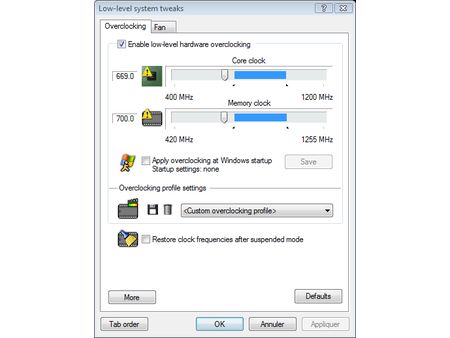Extreme Graphics Card Tuning
Beyond Catalyst
RivaTuner, Once Again
If you want to get more out of your card than the Catalyst drivers allow, what software do you have to use? None other than RivaTuner, once again. The control it allows isn’t as extensive as with an Nvidia card, but the "Low-level System Tweaks" menu allows you to increase the GPU and memory frequencies of a Radeon. There are, however, the same limitations as for GeForce cards. You have to take care to check the stability of your overclocking by making an external test (in other words, running a game), and make sure to check the "Apply overclocking at Windows start-up" box. RivaTuner gives you a lot more latitude in making adjustments than Catalyst does. However, we weren’t able to do any better than what the Overdrive Auto-tune did. Disappointed, we turned to ATI Tray Tools, a very complete utility developed specifically for Radeon cards.
ATI Tray Tools: The Swiss Army Knife
ATI Tray Tools (ATT) has a lot more possibilities – too many, in fact, to go into them all here. Suffice to say that like RivaTuner and nTune, it can create different profiles and load them in certain situations. These profiles store not only the overclocking settings but also all your 3D parameters. The program can also give you very complete information about your card, and even lets you access the Overdrive in the Catalyst drivers. It also has an automatic overclocking mode that’s very similar to the Catalyst Auto-tune. The stability test built into this mode, unfortunately, is too optimistic. It let us push the GPU to 824 MHz; but at that frequency any game we tried to play immediately crashed.
Among all the functions available in ATI Tray Tools, the one that interested us the most for our purposes was the possibility of increasing the GPU voltage. ATT, by allowing us to boost the voltage merely from 1.21 V to 1.254 V, let us increase our GPU to 783 MHz. The memory didn’t go any higher than the 864 MHz we’d already gotten.
Mission Accomplished, but Still Some Shortcomings
At 783 MHz, the RV670 was running as fast on our Radeon HD 3850 as on a Radeon HD 3870. That means we accomplished our mission – we moved up one notch in the product line, and without spending a cent! Well, our card won’t quite match the performance of an HD 3870, since it doesn’t have the same memory bandwidth. But the performance gap will be slight.
Before closing this chapter we should note that once again we weren’t able to exercise any control over the card’s fan with the software, despite the options provided to do that.
Get Tom's Hardware's best news and in-depth reviews, straight to your inbox.
-
jimmysmitty I OC'ed my HD2900Pro 1GB to a 850MHz GPU (from 600MHz) and 2250MHz memory (from 1850MHz). So I technically got alomost a 50% OC. But mine is just a HD2900XT 1GB just down clocked.Reply -
brendano257 The HP disk utility asks me for DOS files to write to the disk where would I find these?Reply -
Shadow703793 To any one interested in modding nVidia BIOS:Reply
http://www.tomshardware.com/forum/forum2.php?config=tomshardwareus.inc&cat=29&post=246611&page=1&p=1&sondage=0&owntopic=3&trash=0&trash_post=0&print=0&numreponse=0"e_only=0&new=0&nojs=0
-
randomizer By the way, the first step in Nibitor is to select the device, before you can read the BIOS ;) I'd like to know how you "deleted" the "Extra" frequencies. Did you set them to 0 or did you actually set the number of performance levels to 3 instead?Reply -
randomizer A good idea for doing blind flashes is to have a second floppy (with the DOS files on obviously) but add a file called autoexec.bat with the following line in it:Reply
nvlfash -4 -5 -6 -a -y file.rom
where file.rom is the filename and it could also be a .bin file. That will flash the card without you having to hope you typed it in right, just make sure you gave it a good minute or two before restarting so you don't corrupt the BIOS. -
randomizer Typo correction - the line in the autoexec.bat file should read:Reply
nvflash -4 -5 -6 -a -y file.rom
Why can't I edit my own comments? -
matthieu lamelot randomizerBy the way, the first step in Nibitor is to select the device, before you can read the BIOS I'd like to know how you "deleted" the "Extra" frequencies. Did you set them to 0 or did you actually set the number of performance levels to 3 instead?Reply
Setting them to zero wouldn't work, you have to set them to dash ( - ), as you can see in the screenshot on page 6. AFAIK, Geforce 8 won't boot correctly if you suppress their "extra" performance level. -
perzy with the really extremly bad cooling on todays GPU's ...a little plastic fan with sleeve bearings that runs slower and slower before it stops completly.. i'm very cautious. New cooling? Yeah, but that costs and then i get a 10% oc. Hmm.Reply



